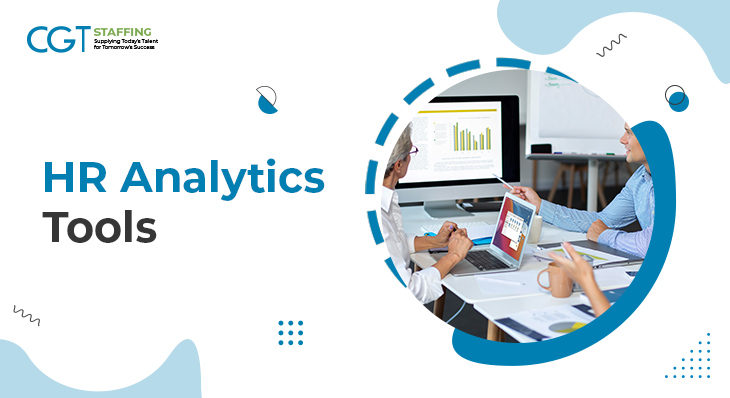Human Resources (HR) professionals today must leverage data-driven insights to make strategic decisions. HR analytics has become a vital tool in optimizing workforce management and enhancing overall organizational performance. To harness the power of HR analytics, it’s essential for HR professionals to be well-versed in the key metrics that drive the HR function. Here are some fundamental HR analytics metrics that every HR professional should be familiar with:
Table of Contents
Employee Turnover Rate
Employee turnover is one of the most critical HR analytics tools that quantifies the rate at which employees leave the organization. A high turnover rate can be a sign of employee dissatisfaction, ineffective recruitment, or inadequate retention strategies. Understanding this metric enables HR professionals to identify areas that need improvement and take corrective actions to reduce attrition.
Time-to-Fill
Time-to-fill measures the duration it takes to fill a job vacancy from the moment it’s posted. A lengthy time-to-fill can lead to operational inefficiencies and increased costs. HR professionals should closely monitor this metric to ensure that their hiring process is swift and efficient, enabling the organization to maintain productivity and reduce talent gaps by leveraging contractual staffing.
Cost-per-Hire
Understanding the cost incurred in acquiring new talent is crucial for evaluating the efficiency of the recruitment process and optimizing the hiring budget for any staffing agency in Pittsburgh or other regions. HR professionals can use the cost per hire metric to assess the effectiveness of recruitment channels, streamline hiring strategies, and minimize recruitment costs without compromising the quality of talent acquisition.
Employee Productivity
Employee productivity metrics help HR professionals assess how efficiently their workforce is performing. Metrics such as revenue per employee, output per hour, or similar indicators offer insights into the workforce’s overall effectiveness. Understanding and improving productivity metrics can boost organizational performance and profitability.
Absenteeism Rate
Tracking the frequency and duration of employee absences provides insights into employee well-being, work-life balance, and organizational culture. A high absentee rate may be an indicator of employee burnout, dissatisfaction, or health-related issues. By analyzing this metric, HR professionals can implement wellness programs, flexible work arrangements, or policies that promote a healthy work environment and enhance employee engagement.
Employee Engagement
Employee engagement is a crucial HR metric that measures the level of commitment and enthusiasm employees have toward their work. Engaged employees tend to be more productive and are less likely to leave the organization. HR professionals can use engagement surveys and feedback to gauge and enhance employee engagement.
Diversity and Inclusion Metrics
Training and Development ROI
Measuring the return on investment (ROI) of training and development initiatives is critical for assessing the effectiveness of employee development programs. HR professionals can utilize this metric to evaluate the impact of training on employee performance, skill enhancement, and overall organizational productivity. Understanding the ROI of training and development helps HR professionals allocate resources efficiently and design tailored learning programs that contribute to long-term organizational growth.
HR-to-Employee Ratio
The HR-to-employee ratio is a valuable metric that helps HR professionals determine the appropriate size of the HR department relative to the total number of employees. An excessively high ratio may indicate inefficiencies in HR operations, while a low ratio may suggest inadequate support. Maintaining an optimal HR-to-employee ratio ensures efficient HR service delivery.
Performance Appraisal Metrics
Evaluating key performance metrics such as employee productivity, efficiency, and quality of work is essential for assessing individual and team performance. HR professionals can use performance metrics to identify top performers, address skill gaps, and provide targeted training and development programs. Analyzing performance metrics enables HR professionals to nurture a high-performing workforce and align individual goals with organizational objectives.
Compensation and Benefits Metrics
Succession Planning Metrics
Succession planning, one of the best HR predictive analytics, ensures that an organization has a pool of talented individuals ready to step into key roles when necessary. HR professionals should track metrics related to the identification and development of high-potential employees and the effectiveness of succession plans.
HR Technology Utilization
The adoption and effectiveness of HR technology can significantly impact the efficiency of HR processes. HR professionals should monitor metrics related to the utilization of HR software, employee self-service, and the impact on administrative workloads.
Employee Net Promoter Score (eNPS)
eNPS is a metric used to measure employee loyalty and willingness to recommend the organization as a great place to work. A high eNPS score indicates a positive work culture and can contribute to better employee retention and recruitment.
Voluntary vs. Involuntary Turnover
HR professionals should differentiate between voluntary and involuntary turnover to identify potential issues within the organization. High involuntary turnover may indicate management, workplace issues, or even insubordination in the workplace, while high voluntary turnover may signal a need for better engagement and retention strategies.
Employee Satisfaction and Feedback
Regular employee satisfaction surveys and feedback mechanisms provide valuable insights into the overall well-being of the workforce. HR professionals should analyze these results to address concerns and improve the workplace environment.
HR Analytics ROI
Measuring the return on investment (ROI) for HR analytics initiatives is essential. HR professionals should track the impact of data-driven decisions on key business outcomes, such as revenue, cost savings, and employee performance improvements.
Conclusion
By understanding and regularly monitoring these key HR analytics tools, HR professionals can make more informed decisions and drive positive changes within their organizations. These metrics provide valuable insights into workforce management, employee engagement, centralized vs decentralized recruitment, and overall organizational performance. Furthermore, they enable HR professionals to align their strategies with the broader business goals, fostering a more productive, satisfied, and diverse workforce.
